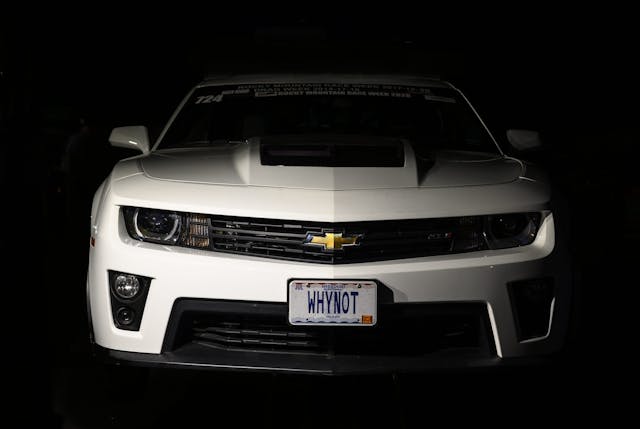A recipe for the perfect “street car”—Tom McGilton’s 2013 Camaro ZL1 on Race Week 2.0
As motorsports evolve and branch off each other, the machines built to dominate these new tangents often create unique opportunities for builders to think outside of the box. A popular and well-treaded class tends to only have a few solutions that are economical to run and proven to win, but when a new format grows, the room to experiment expands with it. The endurance drag racing format that Hot Rod magazine’s Drag Week pioneered allowed participants to depart from traditional drag racing builds in that some sacrifices made for the sake of weight were acceptable in order to maximize comfort or reliability on the street.
Few machines are more focused-built than Tom McGilton’s 2013 Camaro ZL1, which won Drag Week’s Pro Street Power Adder class in its debut 2015 race and took home $30,000 this year after winning both Rocky Mountain Race Week (RMRW) events. The ZL1 is the culmination of a lifetime of racing that emphasizes modern comfort with brutal performance. Beneath the stock sheet metal is a disciplined drivetrain and chassis that’s capable of chugging down the road on 87-octane while still tearing down the quarter-mile in the low-sevens—while blasting the air-conditioning, flipping through XM radio channel favorites, or even calling OnStar for a lock-out. He didn’t just want one of the fastest street cars in the world, instead, Tom wanted comfort. AS McGilton said, “I wanted everything to be just like you’re driving down the road with automatic headlights with air-conditioned seats blasting. I wanted it to be like factory.”
The transformation began when the ZL1 had less than 100 miles on the odometer. That’s when it was turned over to Larson Race Cars to become a silhouette of itself. Underneath its modern muscle car package is a Pro-Mod chassis. The front suspension was replaced by a fly-weight coil-over strut setup while the rear of the ZL1 was hogged out for a tubular chassis that could fit a narrow Mark-Williams 9-inch, which is supported by a parallel four-link and located laterally by a wishbone link. The 9-inch uses a 3.70:1 ratio. When backed by a heavily-modified Rossler TH210 trans and Gear Vendors overdrive unit, the ZL1 has an optimized ratio for making passes while also lowering cruise RPMs preserve engine longevity on the freeway.
The 540ci aluminum big-block was machined by CFE Racing and was topped with BMF heads with massive 405 cc runners. A pair of 88mm turbos built by Heart Diesel feed boost through an ice-chilled air-to-water intercooler. Thanks to the relatively low compression afforded by forced induction, the 540 can even burn 87-octane on the street tune by dialing out boost. But when set on full-kill with C16 pumped in from a secondary fuel tank, the ZL1 is a brutal test of physics. The no-compromise ethos of the interior means that this 7-second grand tourer still weighs over 4200 pounds at the start line, heavier than Royce Payton’s screw-blown Mustang by some 500 pounds, making its performance all that much more impressive.
“I’m trying to get into the sixes. I could probably get into the 6.90s pretty easily if I pulled some weight out of it, but I don’t want to do that—I want everything in it,” he challenged. “It’s all factory steel, the only piece of carbon is the factory scoop.”
This year’s second win with RMRW 2.0 was relatively painless for McGilton with the ZL1 being so well sorted, but only through its consistency did it hold onto the lead against pressure from Royce’s screw-blown Mustang along with the Supra piloted by Geovanni Castillo, who began a mid-week charge for low sevens that put the six-cylinder import squarely in McGilton’s mirrors.
“If he would have been down the sevens all week, I probably wouldn’t have won it because he was running 200 mph at an 8.0,” McGilton explained, with the relatively high speed for the given ET indicating that the Supra was capable of much more. “They said they were running in the 6.90s the day before we started. If they stayed in the sevens, it would’ve been a close race all the way through.” Payton’s maniacal Mustang also was a hot pick for the overall win, but a mid-week stumble at Thunder Valley where every attempt became a pedalfest pulled his average down, tying with Castillo for the week with a 7.6338 average. The low-drama attitude of the ZL1, with its delayed onset of power provided by the turbos in juxtaposition to Royce’s supercharged slap to the face at the line, kept McGilton safely away from anything slower than a 7.356 all week, building the buffer needed to keep his lead secured.
Despite finding new personal bests while also winning both RMRW events this year, McGilton emphasizes how relatively relaxed the event is compared to other drag racing formats. “I was just out there to have a good time,” he said. “Like Royce ripped a tire innertube and needed some valve stem parts at RMRW 1.0, I had them. He was right on my tail and if I wanted to be a jerk about it I could’ve said ‘no,’ but I want everyone to see everyone competing. Really, you’re competing against yourself, as far as I’m concerned. Is it good to win? Hell yes, don’t get me wrong, but it’s a better feeling to start and finish with everyone, especially with no problems.”
Beyond the track, McGilton’s ZL1 has become a gateway for drag racing fans, with a trove of kids and adults hopping inside for photos, even at the confusion of some onlookers. “I’ve had people ask, ‘Man, you’re letting them sit in your car?'” he mentioned as many folks were accustomed to over-protective owners at car shows and races. Having fueled his own obsession without the more typical family influence, McGilton’s willingness to share the ZL1 all adds up to the Why Not? attitude of the build.


